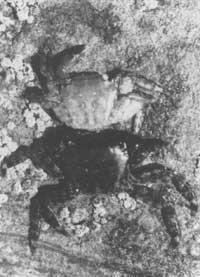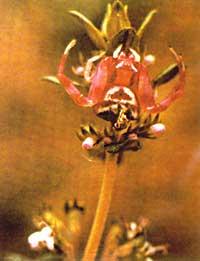Muda of the "Pachygrapsus Marmoratum"
1989/10/01 Torrubia, A. Iturria: Elhuyar aldizkaria
It consists of ten bodies, eight of them, four on each side, are mobilizers, while the previous two are dental. In each of them you can distinguish three parts, ending the cushions in a kind of bark.
Therefore, the holding capacity of this crab allows it to be on the rocks, even in vertical or vertical situations.
In general, the size of this shell does not usually exceed 5 centimeters, except for some exceptions that can be found in the docks (here they have more protection and better feeding). Common crabs, being adults, normally have a shell between 2.5 and 3.5 centimeters.

Between the sea and the earth, its tradition is related to the time of life, in this research the greatest curiosity is in the growth. The objective of this work is precisely the explanation of this phenomenon.
In spring and autumn, but especially during the summer, this spectacular phenomenon is manifested in the pools that occur when the low tide occurs. Inside the crab, for about fifteen days, what was once a thin, hairy skin, becomes a hard shell. From now on there are some changes. The crab leaves the heights of the rocks that are usually found to go to the wettest areas of the wells.
Your shell becomes reddish and your belly breaks. In addition to increasingly clumsy movements, its puncture ability with dental limbs weakens. In addition, the crab resorts to horizontal or transversal aspects. All this makes us think that it loses its ability to adhere to the rock. As this development progresses it is increasingly spectacular. The crab enters the well and slowly displaces its old shell within twenty minutes, the last limbs coming out of the molt of the teeth approximately.
All this seems to be a huge expense. After leaving the dumb, she stands still beside her. The color of the crab has changed; the molt is lighter and smaller, its new skin is black and is totally soft, unlike the previous one.
Although it is not so spectacular, the crab comes fast in its favor. If you overcome the risks arising from your weakness, which can be consumed by this or other types of marine animals, you will get hardened in less than three days.
From the dismantling of the skin, half an hour begins to give signs of life moving the extremities; little by little its first surface is removed, totally breaking with the pleamar.
As you move, your skin is hardening, however, you do not have enough strength to get out of the well or the hardness of your limbs.
In this well it will take between two and three hours to achieve its motor capacity, color and adhesion, although it is not yet able to move away from the humid areas.
From two to three days it needs its total hardness, its ability to adhere and its color to recover, in this way we can see again this crab so known in our rocks.

Gai honi buruzko eduki gehiago
Elhuyarrek garatutako teknologia




